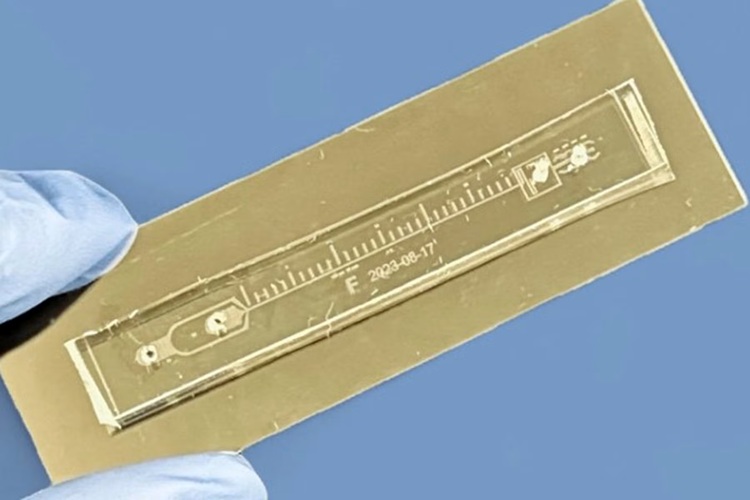New Point of Care Tests to Help Reduce Overuse of Antibiotics
|
By LabMedica International staff writers Posted on 27 Jan 2025 |

The misuse of antibiotics—such as taking them unnecessarily, for too long, or in incorrect doses—leads to antimicrobial resistance (AMR), making infections harder to treat and increasing the risks of severe illness and death. AMR causes 700,000 global deaths annually, and many people either expect antibiotics from doctors or misuse them by not following prescribed dosages. Doctors face challenges in prescribing antibiotics due to diagnostic uncertainty, patient self-diagnosis, and limited resources. Now, two new tests for bacterial infections could help reduce the overuse of antibiotics for common respiratory illnesses.
Researchers at Deakin University (Victoria, Australia) are leading trials of the two new tests involving a simple finger prick or throat swab that provide immediate results to distinguish between bacterial and viral infections. This can enable more accurate diagnoses and targeted treatments, potentially reducing unnecessary antibiotic prescriptions. In international trials conducted earlier, the finger prick test has already shown promise, while early results from the latest trial indicate a reduction of antibiotic use by up to 30%. This test can help doctors determine if common respiratory infections are bacterial or viral, ensuring antibiotics are only prescribed when necessary.
The second test, a throat swab, allows doctors to quickly identify if a sore throat is caused by Strep A bacteria, a common source of throat infections. Despite Strep A being responsible for only 15 to 20% of sore throats, antibiotics are often overprescribed in 70% of cases. Proper diagnosis and early treatment are critical, especially in children, as Strep A can lead to severe complications like rheumatic heart disease. This throat swab test will optimize antibiotic treatment for Strep A. A feasibility trial conducted in 2024 with 200 patients across five clinics, followed by a pilot trial in 2025 with 400 patients, aims to further assess the test’s effectiveness in reducing antibiotic overuse. Both these trials hold the potential to significantly improve the responsible use of antibiotics.
“This work is trying to improve the capacity of GPs and community pharmacists with point-of-care diagnostic testing services,” said Dr. Sajal Saha, Research Fellow in the Centre for Innovation in Infectious Disease and Immunology Research. “This will help prescribers better understand the severity of infections or confirm bacterial infections for some respiratory infections during patient consultations and prescribe antibiotics accordingly.”
Related Links:
Deakin University
Latest Microbiology News
- Blood-Based Molecular Signatures to Enable Rapid EPTB Diagnosis
- 15-Minute Blood Test Diagnoses Life-Threatening Infections in Children
- High-Throughput Enteric Panels Detect Multiple GI Bacterial Infections from Single Stool Swab Sample
- Fast Noninvasive Bedside Test Uses Sugar Fingerprint to Detect Fungal Infections
- Rapid Sepsis Diagnostic Device to Enable Personalized Critical Care for ICU Patients
- Microfluidic Platform Assesses Neutrophil Function in Sepsis Patients
- New Diagnostic Method Confirms Sepsis Infections Earlier
- New Markers Could Predict Risk of Severe Chlamydia Infection
- Portable Spectroscopy Rapidly and Noninvasively Detects Bacterial Species in Vaginal Fluid
- CRISPR-Based Saliva Test Detects Tuberculosis Directly from Sputum
- Urine-Based Assay Diagnoses Common Lung Infection in Immunocompromised People
- Saliva Test Detects Implant-Related Microbial Risks
- New Platform Leverages AI and Quantum Computing to Predict Salmonella Antimicrobial Resistance
- Early Detection of Gut Microbiota Metabolite Linked to Atherosclerosis Could Revolutionize Diagnosis
- Viral Load Tests Can Help Predict Mpox Severity
- Gut Microbiota Analysis Enables Early and Non-Invasive Detection of Gestational Diabetes
Channels
Clinical Chemistry
view channel
Chemical Imaging Probe Could Track and Treat Prostate Cancer
Prostate cancer remains a leading cause of illness and death among men, with many patients eventually developing resistance to standard hormone-blocking therapies. These drugs often lose effectiveness... Read more
Mismatch Between Two Common Kidney Function Tests Indicates Serious Health Problems
Creatinine has long been the standard for measuring kidney filtration, while cystatin C — a protein produced by all human cells — has been recommended as a complementary marker because it is influenced... Read moreMolecular Diagnostics
view channel
Urine Test Detects Inherited Neuropathy Missed by Genetic Screening
Sorbitol dehydrogenase (SORD)-related neuropathy is one of the most common inherited nerve disorders, yet diagnosis often lags because current genetic screens frequently miss the causal gene.... Read more
Genomic Test Predicts Risk of SCC Metastasis
Managing squamous cell carcinoma (SCC) of the skin in patients with one or more risk factors is a significant clinical challenge, especially as SCC-related deaths are now estimated to exceed those from melanoma.... Read moreHematology
view channel
Platelet Activity Blood Test in Middle Age Could Identify Early Alzheimer’s Risk
Early detection of Alzheimer’s disease remains one of the biggest unmet needs in neurology, particularly because the biological changes underlying the disorder begin decades before memory symptoms appear.... Read more
Microvesicles Measurement Could Detect Vascular Injury in Sickle Cell Disease Patients
Assessing disease severity in sickle cell disease (SCD) remains challenging, especially when trying to predict hemolysis, vascular injury, and risk of complications such as vaso-occlusive crises.... Read more
ADLM’s New Coagulation Testing Guidance to Improve Care for Patients on Blood Thinners
Direct oral anticoagulants (DOACs) are one of the most common types of blood thinners. Patients take them to prevent a host of complications that could arise from blood clotting, including stroke, deep... Read moreImmunology
view channel
Chip Captures Cancer Cells from Blood to Help Select Right Breast Cancer Treatment
Ductal carcinoma in situ (DCIS) accounts for about a quarter of all breast cancer cases and generally carries a good prognosis. This non-invasive form of the disease may or may not become life-threatening.... Read more
Blood-Based Liquid Biopsy Model Analyzes Immunotherapy Effectiveness
Immunotherapy has revolutionized cancer care by harnessing the immune system to fight tumors, yet predicting who will benefit remains a major challenge. Many patients undergo costly and taxing treatment... Read morePathology
view channel
Blood Test and Sputum Analysis Predict Acute COPD Exacerbation
Chronic obstructive pulmonary disease (COPD) remains a major contributor to global illness, largely driven by cigarette smoking and marked by irreversible lung damage. Acute exacerbations can accelerate... Read more
AI Tool to Transform Skin Cancer Detection with Near-Perfect Accuracy
Melanoma continues to be one of the most difficult skin cancers to diagnose because it often resembles harmless moles or benign lesions. Traditional AI tools depend heavily on dermoscopic images alone,... Read more
Unique Immune Signatures Distinguish Rare Autoimmune Condition from Multiple Sclerosis
Myelin oligodendrocyte glycoprotein antibody–associated disease (MOGAD) is a rare autoimmune disorder in which the immune system attacks the myelin sheath in the central nervous system. Although symptoms... Read moreTechnology
view channel
AI Saliva Sensor Enables Early Detection of Head and Neck Cancer
Early detection of head and neck cancer remains difficult because the disease produces few or no symptoms in its earliest stages, and lesions often lie deep within the head or neck, where biopsy or endoscopy... Read more
AI-Powered Biosensor Technology to Enable Breath Test for Lung Cancer Detection
Detecting lung cancer early remains one of the biggest challenges in oncology, largely because current tools are invasive, expensive, or unable to identify the disease in its earliest phases.... Read moreIndustry
view channel
Abbott Acquires Cancer-Screening Company Exact Sciences
Abbott (Abbott Park, IL, USA) has entered into a definitive agreement to acquire Exact Sciences (Madison, WI, USA), enabling it to enter and lead in fast-growing cancer diagnostics segments.... Read more




 assay.jpg)


















